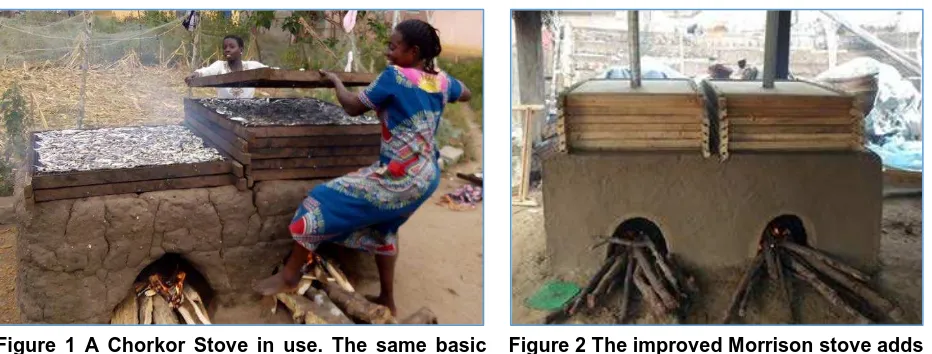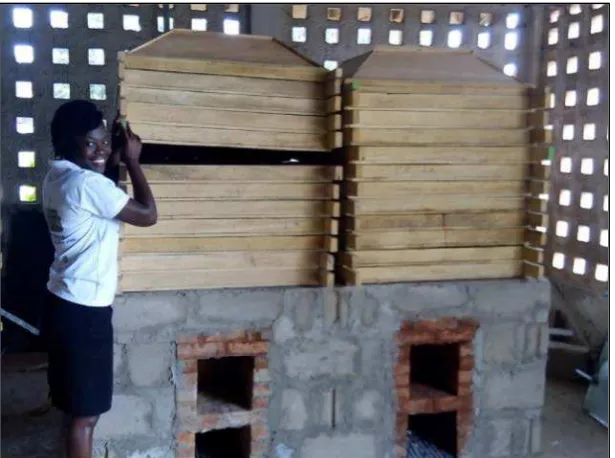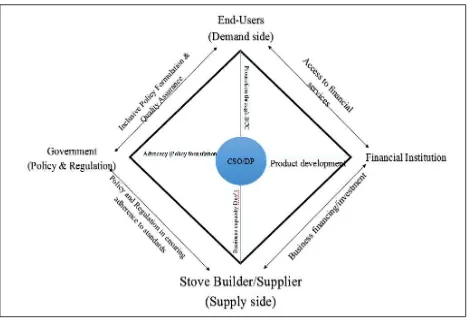SUSTAINABLE FISHERIES
MANAGEMENT PROJECT (SFMP)
Fisheries Value Chain Development:
Scale-up Extension Strategies for
Improved Smoker Technologies
This publication is available electronically on the Coastal Resources Center’s website at http://www.crc.uri.edu/projects_page/ghanasfmp/
For more information on the Ghana Sustainable Fisheries Management Project, contact:
USAID/Ghana Sustainable Fisheries Management Project Coastal Resources Center
Graduate School of Oceanography University of Rhode Island
220 South Ferry Rd.
Narragansett, RI 02882 USA
Tel: 401-874-6224 Fax: 401-874-6920 Email: info@crc.uri.edu
Citation: SNV Netherlands Development Organisation, Central and Western Region
Fishmongers Improvement Association, and Coastal Resources Center. (2016). Fishing Community Livelihood Value Chain Development and Post-harvest Improvements: An Extension Strategy for the Scale-up of Improved Smoker Technologies Coast-wide. The USAID/Ghana Sustainable Fisheries Management Project (SFMP). Narragansett, RI: Coastal Resources Center, Graduate School of Oceanography, University of Rhode Island, Central and Western Region
Fishmongers Improvement Association and the Netherlands Development Organisation SNV. GH2014_ACT086_CEW_SNV 9 pp.
Authority/Disclaimer:
Prepared for USAID/Ghana under Cooperative Agreement (AID-641-A-15-00001), awarded on October 22, 2014 to the University of Rhode Island, and entitled the USAID/Ghana Sustainable Fisheries Management Project (SFMP).
This document is made possible by the support of the American People through the United States Agency for International Development (USAID). The views expressed and opinions contained in this report are those of the SFMP team and are not intended as statements of policy of either USAID or the cooperating organizations. As such, the contents of this report are the sole responsibility of the SFMP team and do not necessarily reflect the views of USAID or the United States Government.
Cover photo: A Chorkor Stove in use. The same basic design is now used throughout West
iii
Detailed Partner Contact Information:
USAID/Ghana Sustainable Fisheries Management Project (SFMP) 10 Obodai St., Mempeasem, East Legon, Accra, Ghana
Telephone: +233 0302 542497 Fax: +233 0302 542498
Brian Crawford Chief of Party brian@crc.uri.edu
Najih Lazar Senior Fisheries Advisor nlazar@crc.uri.edu Patricia Mensah Communications Officer patricia.sfmp@crcuri.org
Bakari Nyari Monitoring and Evaluation Specialist hardinyari.sfmp@crcuri.org Don Robadue, Jr. Project Manager, CRC don@crc.uri.edu
Justice Odoi USAID Administrative Officer Representative Jodoi@usaid.gov
Kofi.Agbogah #3 Third Nautical Close,
Nungua, Accra, Ghana
giftyasmah@Daasgift.org Daasgift Quality Foundation
Headmaster residence, Sekondi College Sekondi, Western Region, Ghana 233 243 326 178
For additional information on partner activities:
CRC/URI: http://www.crc.uri.edu
CEWEFIA: http://cewefia.weebly.com/
DAA: http://womenthrive.org/development-action-association-daa Daasgift:
https://www.facebook.com/pages/Daasgift-Quality-Foundation-FNGO/135372649846101 Friends of the Nation: http://www.fonghana.org Hen Mpoano: http://www.henmpoano.org
SNV: http://www.snvworld.org/en/countries/ghana SSG Advisors: http://ssg-advisors.com/
LIST OF FIGURES
1
INTRODUCTION TO THE PROJECT
The SFMP is a Feed the Future Initiative funded by USAID/Ghana and implemented by the University of Rhode Island and a number of local implementing partners, including SNV Netherlands Development Organization. The primary goal is to rebuild targeted marine fish stocks through the adoption of responsible fishing practices and sustainable harvesting levels. The small pelagic stocks are the primary target of the project as fish provides more than 60% of the animal protein in the local diet and these stocks make up a majority of the fish landings in the country. They are a low-cost and highly nutritious local food supply. The small pelagics are mainly caught by over 100,000 canoe fishermen, and processed and marketed by over 30,000 women. Overfishing and illegal fishing have led to a significant decline in the landings of these stocks over the last two decades.
OVERVIEW OF THE SMALL PELAGIC VALUE CHAIN AND KEY
ISSUES
Fish processing is the main economic activity for women living in and around the coastal and lake areas of Ghana. Preservation methods include salting, frying and freezing, but smoking is the most prevalent form: practically all species of fish available in the country can be smoked and it is estimated that 75% of the domestic marine and freshwater catch is processed this way. Most processed fish is sold in major markets across the country and within the West African region, with some products making their way through to the global diaspora.
Poor product quality and unhygienic handling practices are a major concern in the local fish processing industry. The illegal use of chemicals and explosives in fishing are a major
contributor to poor quality of fish caught. Microbiological contamination can occur at multiple points through the value-chain, through the use of unclean sea or fresh water and through processing, storage and sale of fish in poorly kept and unhygienic surroundings.
The fish smoking sector in Ghana is highly dependent on fuelwood as a source of energy, and in a 2014 study, SNV found that there were over 120,000 fish smoking stoves in near-constant use along Ghana’s coastline and the Volta Lake basin. Where there are limited forest wood
resources, mangrove is used and the extent and rate of mangrove forest depletion outstrips the slow rate of regeneration, leading to the degradation of these forest systems. Between 2005 and 2010, Ghana’s deforestation rate was estimated at 2.2% per annum, the sixth highest
deforestation rate globally for that period.
Figure 1 A Chorkor Stove in use. The same basic design is now used throughout West Africa
Figure 2 The improved Morrison stove adds a number of energy efficient features
The smoking and drying techniques of the Chorkor stove have limitations that deserve greater attention in order to significantly improve livelihoods of small-scale fishers and respond effectively to product safety challenges – especially linked to controlling contamination by polycyclic aromatic hydrocarbons (PAH), a public health hazard. PAH are carcinogenic, fat soluble, nonvolatile and extremely persistent, and develop especially during the incomplete combustion of organic materials. Globally, PAH levels in food are monitored by regulatory agencies with a combination of four compounds (PAH4) being of specific interest:
benz[a]anthracene, chrysene, benzo[b]fluorantene and benzo[a]pyrene. Under EU food standards, the level of PAH4 in smoked food products should not exceed 12 µg/kg and for benzo[a]pyrene (BaP) 2 µ/kg.
Figure 3 The impact of stove type on PAH levels in soft-smoked fish
Recent SFMP analyses have shown that smoked fish contains PAH levels that are well above those recommended for human health, with the Chorkor stove 7-10 times the EU standard and the Morrison stove, an earlier improved stove type, 9-15 times higher depending on the indicator used. One very recent study sampled hard-smoked fish from markets across multiple coastal regions and found PAH4 levels in excess of 400 µg/kg.
The formation of PAH is a complex and little understood process with respect to traditional fish smoking practices and is dependent on the stove technology, fish species, wood type and
smoking method1. Through literature reviews and Project research, it appears that influential
1
Soft smoking takes ~2 hours and yields a 40-55% moisture content and a shortened shelf life of 1-3 days so limiting market distribution radius. Hard smoking, usually preceded by soft smoking, takes 10-18 hours and yields a 10-15% moisture content and a shelf life of 6-9 months if stored properly so can be traded over a larger area.
EU Limits Chorkor Morrison Ahotor Down-draft
3
factors include the incomplete combustion of wood, dripping of fat onto an open fire, and exposure to excessive heat and smoke.
The high PAH levels present in Ghanaian smoked fish present an alarming issue with the impact on population health at the macro level as yet unknown. However, with smoking serving
multiple purposes - preserving, flavoring and coloring - the practice will continue as these are an important part of what the consumer values in the product. The type of producer is also unlikely to change and so if this health issue is to be addressed, new types of low-PAH fish smoking stoves will need to be developed that are energy-efficient, low cost and made with local materials and manufacturing processes.
THE SFMP APPROACH
The SFMP takes an integrated approach to improvements in the fisheries sector. While
overfishing and illegal fishing are of main concern, poor post-harvest practices are also targeted for improvements. This is especially important from a gender perspective as the post-harvest value chain is dominated by women. Women often own fishing vessels, and fund fishing trips, so they can also play a role in promoting responsible fishing practices as their businesses are also affected by declining catches due to overfishing. Over the life of the Project, more than 4000 micro, small and medium scale businesses involved in the fish value chain will have benefited from post-harvest improvements.
Adoption of the improved smoker technology is a major component of this approach. Several partners are involved in the value chain components of the Project with SNV leading the technology R&D, and scale-up and sustainability strategy development that is driven by the private sector. Several local women-led processor associations including DAA, CEWEFIA and DQF are supporting the extension activities in approximately a dozen major fish landings sites along the coast. Specific activities have included:
Improved Processing, Packaging and Handling
The implementing partners working on the post-harvest component of the project have carried out healthy fish handling behavioral change campaigns in the Central and Western Regions of Ghana. The campaigns are a medium for sensitizing fish processors on the need to process fish in a healthy environment and on their right to “Say No to bad fish” sold to them by the
fishermen. Apart from the campaigns there are several women group trainings ongoing, where the processors are taken through practical trainings on personal hygiene, hygienic and better packaging, environmental sanitation and how to process fish and maintain their processing materials in a hygienic manner.
Initial Promotion of the Morrison Stove
The Morrison Stove is a product of Morrison Energy Limited, a private enterprise that aims at improving the fish smoking industry with energy efficient and user friendly stove technologies. The Morrison stove (Figure 2) was identified for promotion under the USAID/Ghana
Sustainable Fisheries Management Project due to its energy efficiency advantage over the Chorkor smoker. An assessment by the Institute of Industrial Research indicated a fuelwood saving of 37% as compared to the Chorkor stove for smoking the same quantity of fish. However, a later PAH analysis (Figure 3) showed that the Morrison stove produced fish with higher levels of both PAH4 and BaP as compared to the Chorkor. For this reason the promotion of this stove model was paused and a phase of research and development initiated to better understand PAH issues.
Improved low-PAH Smoking Stove Development
Fisheries Commission, and with testing support from the Ghana Standards Authority and the Institute of Industrial Research of CSIR.
One key element of this process was the development of a fired-brick combustion chamber that allows for the use of a smaller but efficient fire, the combustion gases from which are then pre-mixed with a larger flow of clean air, to give a faster flowing but cooler gas stream at an optimal temperature of ~120°C (250°F). This is then used to smoke/dry the fish in conditions that prevent the formation of high PAH levels.
The Ahotor or Comfort stove (Figure 4) is comprised of this combustion chamber fitted centrally to a Chorkor or Morrison-like outer shell, with fish processing trays above as in normal
operation. It can be either a retrofit or a new-build, with the latter made from sandcrete blocks and cement, and also as a single or double unit. Above the combustion chamber, a fat collecting tray is fitted that allows the hot gases to flow up through to the fish while preventing any fat from falling down onto the fire. A PAH analysis showed that the Ahotor stove (Figure 4) achieved 6 µ g/kg and 53 µg/kg for BaP and PAH4 respectively, considerably lower than the Chorkor (Figure 3). In addition the stove was 32% more fuel efficient than the Chorkor.
Figure 4 A double-unit Ahotor stove, offering lower-PAH levels and an improved energy efficiency
5
Sustainable Scale-up Strategy
A sustainable scale-up strategy has been developed for the promotion of the improved stoves, comprising a business/financial model and awareness creation for a healthy fish market. A ‘Diamond’ operating model has been utilized that focuses on linking stove construction
companies with local financial intuitions, to provide small loans to fish smoking women to buy an improved stove, and with a Project involvement that phases out over time (Figure 5).
The project is providing a 30% incentive for the first 150 early adopters of an improved stove.
The strategy provides options for beneficiaries to acquire the oven by accessing small loans from designated Rural Banks or acquiring the oven directly from Project-approved stove construction companies. To date, nine stove construction companies have been identified and trained and will work with the Project to ensure quality control and continued product development.
Finally, the project is looking to develop a market for healthy fish, where fish processors can realize an increased margin for a better quality product. If this can be achieved the market ‘pull’ will lead to a much greater adoption of healthy fish practices and the uptake of larger numbers of low-PAH, energy efficient stoves.


